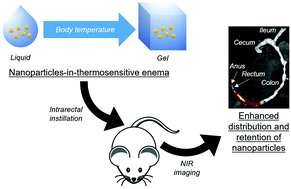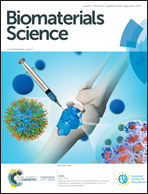Colorectal distribution and retention of polymeric nanoparticles following incorporation into a thermosensitive enema†
Abstract
Nanotechnology-based systems have been proposed for rectal drug delivery, often rendering promising outcomes concerning disease prophylaxis or therapeutics. However, nanocarriers often feature reduced colorectal retention when administered in liquid vehicles (enemas). Semi-solid platforms may be considered as alternative but usually result in limited local distribution. Thermosensitive enemas undergoing sol–gel transition just below body temperature have been used for abbreviating these issues, but the actual impact on the colorectal distribution and retention of incorporated nanosystems is not clear. We prepared and characterized a potential drug delivery platform by incorporating poly(lactic-co-glycolic acid)-based nanoparticles (170–180 nm mean hydrodynamic diameter) into a poloxamer 407-based thermosensitive enema (NPs-in-thermo). The system featured suitable functional properties for rectal administration such as sol–gel transition temperature of approximately 27–28 °C, sol–gel transition time of 1.6 min, and viscosity around 31 and 2100 mPa s at 20 °C and 37 °C, respectively. NPs-in-thermo presented osmolality and pH values deemed compatible with the colorectal compartment, as well as reduced toxicity to the Caco-2 colorectal cell line. The composite system was also used to incorporate the anti-HIV microbicide model drug dapivirine. In vitro studies showed that dapivirine-loaded NPs-in-thermo was able to provide overall faster drug release as compared to dapivirine directly dispersed into phosphate buffered saline or the thermosensitive enema base. Finally, NPs-in-thermo was tested for distribution and retention in a mouse model by in vivo and ex vivo near infrared imaging. Qualitative and semi-quantitative data indicated that NPs exhibited slower but overall wider distribution and enhanced retention in the distal colon of mice treated intrarectally with NPs-in-thermo, namely when compared to NPs dispersed in liquid phosphate buffered saline. Overall, our data support that thermosensitive enemas may provide suitable platforms for the rectal administration of polymeric NPs, namely in the context of drug delivery.



 Please wait while we load your content...
Please wait while we load your content...